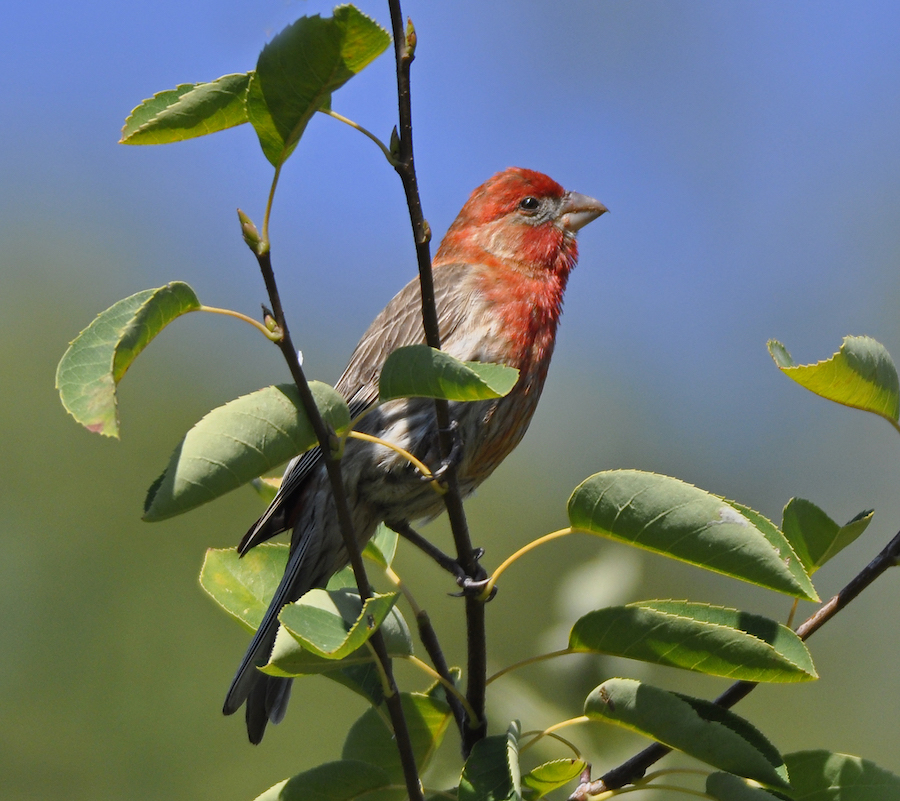You know the old aphorism that the road to hell is paved with good intentions? Well, that may be the case with your bird feeders.Putting out bird feeders is a great way to provide sustenance to birds during harsh winter months, but the feeders may also be helping the spread of a bacterial infection called mycoplasmal conjunctivitis, according to recent research in the Proceedings of the Royal Society B.Researchers found in Virginia that House Finches that often visited feeders were more likely to spread the eye infection. Here’s more from the lead researcher:“If you’re interested in reducing the incidence of a disease, understanding which individuals are likely to transmit pathogens is critical, especially when transmission might be taking place literally in our backyards,” said James Adelman, lead author of the study and an assistant professor of natural resource ecology and management at Iowa State.They found this out by putting tiny transponders on the finches and then tracking their activities at bird feeders. The finches that spent more time around feeders were more likely to contract the infection.So what does that mean for you?Yes, bird feeders have the potential to spread diseases. This isn’t something we didn’t know about. There have been cases of salmonellosis killing birds a while back, but that doesn’t mean bird feeders are bad.The benefits definitely outweigh the risks. (I outlined some of the benefits to bird feeding a few months ago.) Also, the risk to birds is easily minimized with a little elbow grease.Cleaning bird feeders is the pits, but if you disinfect and clean thoroughly every time you refill it, you’ll help stop the spread of diseases among birds while giving valuable nourishment.
Here’s more from the lead researcher:“If you’re interested in reducing the incidence of a disease, understanding which individuals are likely to transmit pathogens is critical, especially when transmission might be taking place literally in our backyards,” said James Adelman, lead author of the study and an assistant professor of natural resource ecology and management at Iowa State.They found this out by putting tiny transponders on the finches and then tracking their activities at bird feeders. The finches that spent more time around feeders were more likely to contract the infection.So what does that mean for you?Yes, bird feeders have the potential to spread diseases. This isn’t something we didn’t know about. There have been cases of salmonellosis killing birds a while back, but that doesn’t mean bird feeders are bad.The benefits definitely outweigh the risks. (I outlined some of the benefits to bird feeding a few months ago.) Also, the risk to birds is easily minimized with a little elbow grease.Cleaning bird feeders is the pits, but if you disinfect and clean thoroughly every time you refill it, you’ll help stop the spread of diseases among birds while giving valuable nourishment.
 Here’s more from the lead researcher:“If you’re interested in reducing the incidence of a disease, understanding which individuals are likely to transmit pathogens is critical, especially when transmission might be taking place literally in our backyards,” said James Adelman, lead author of the study and an assistant professor of natural resource ecology and management at Iowa State.They found this out by putting tiny transponders on the finches and then tracking their activities at bird feeders. The finches that spent more time around feeders were more likely to contract the infection.So what does that mean for you?Yes, bird feeders have the potential to spread diseases. This isn’t something we didn’t know about. There have been cases of salmonellosis killing birds a while back, but that doesn’t mean bird feeders are bad.The benefits definitely outweigh the risks. (I outlined some of the benefits to bird feeding a few months ago.) Also, the risk to birds is easily minimized with a little elbow grease.Cleaning bird feeders is the pits, but if you disinfect and clean thoroughly every time you refill it, you’ll help stop the spread of diseases among birds while giving valuable nourishment.
Here’s more from the lead researcher:“If you’re interested in reducing the incidence of a disease, understanding which individuals are likely to transmit pathogens is critical, especially when transmission might be taking place literally in our backyards,” said James Adelman, lead author of the study and an assistant professor of natural resource ecology and management at Iowa State.They found this out by putting tiny transponders on the finches and then tracking their activities at bird feeders. The finches that spent more time around feeders were more likely to contract the infection.So what does that mean for you?Yes, bird feeders have the potential to spread diseases. This isn’t something we didn’t know about. There have been cases of salmonellosis killing birds a while back, but that doesn’t mean bird feeders are bad.The benefits definitely outweigh the risks. (I outlined some of the benefits to bird feeding a few months ago.) Also, the risk to birds is easily minimized with a little elbow grease.Cleaning bird feeders is the pits, but if you disinfect and clean thoroughly every time you refill it, you’ll help stop the spread of diseases among birds while giving valuable nourishment.

